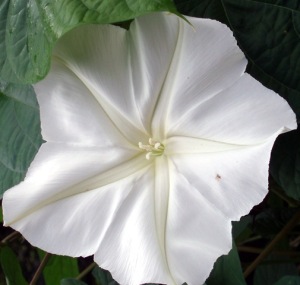
Ipomoea alba. http://www.joenesgarden.com.
No flower is perhaps so striking by moonlight as the moonflower. What is otherwise a rather unscrupulous vine by day suddenly becomes the focus of nature’s attention, for as moonlight hits the plant, little moons suddenly appear from the otherwise gangly vine, beckoning moths from miles around to drink its magical elixir. Moonflower is not shy about its night display, and tens if not hundreds of flowers will glow with the moonlight on a large vine. This plant is steeped in magic, and certainly fairies will gather to frolic around the flowers when prying eyes are no longer awake to ruin their night dance.
Indeed many poems could be written about the magical display of the moonflower, not only for its look but also its scent. Moonflower is also steeped in mystique for gardeners, for it is unfortunately rather short lived outside the tropics. Moonflower is an unfortunate annual in areas of freeze, and may only bloom for a few weeks in most places before this un-comely event occurs. Moonflower also only blooms at equatorial day lengths (i.e. it only blooms when days are 12 hours or less) further making its anticipated debut almost too late to enjoy for so many.
This relative of the Morning glory family is native to the Central and South American tropics, and can grow to eventually be a twinning vine up to one hundred feet tall, with heart-shaped leaves. The real show is in the night-blooming flowers, which begin as tightly wound buds that have a most interesting spiral shape, that open to large, six inch flowers. The corolla is white, but with yellowish star-like veins. The scent is not one that is easily spread through the night garden like many others, but is quite like the scent of Brunfelsia gigantea, although lighter in essence and with a lemony-flair. Its a very delicate scent that I love, even if it is so short-lived.
Growing these vines is easily done from seed, but the vine does not transplant well. Seeds ought to be sown directly in the garden, after having been soaked overnight in warm water and nicked with a knife prior to sowing. The vine is slow to grow as well, needing warm soil temperatures and warm weather to grow quickly; but given a large trellis or support, it will grow almost a foot a day in the middle of the summer! Lastly, buds will only appear near the equinox, and flowering is most done in late September and early October. For the southern garden and well-protected Northern garden, this is a month or less of display before an unfortunate frost-nip, but the small bloom window is well worth a summer of growth if just for the scent of a moonflower under the bright autumn moon.
